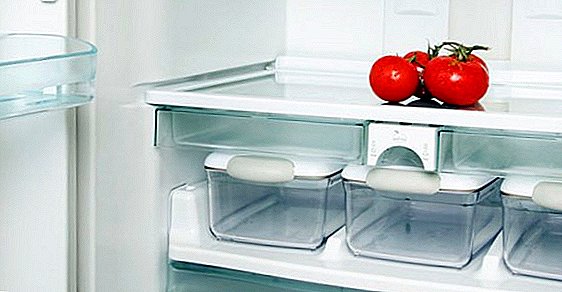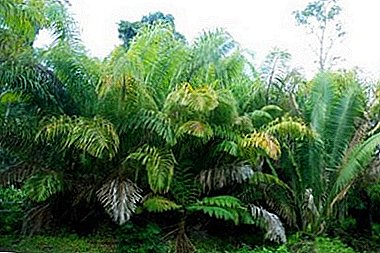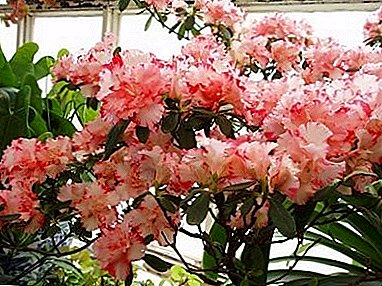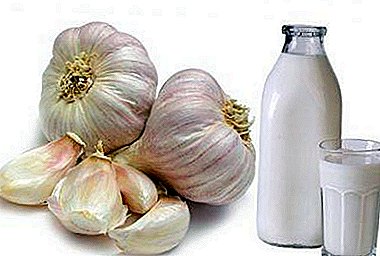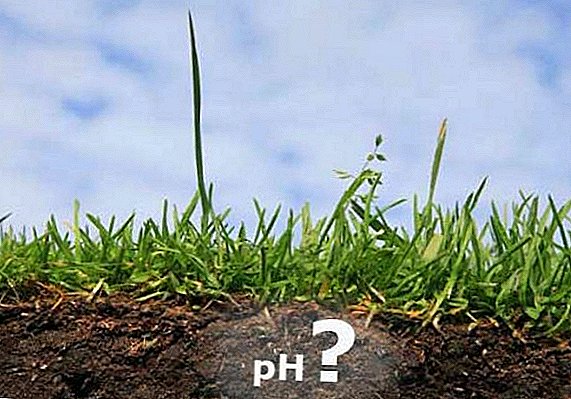 What is the acidity of the soil in their own garden, not all landowners know. Many are lost at the sight of an incomprehensible abbreviation of pH and numerical values after it on the packages of store mixes. Although in fact it is the most important information for the organization of competent sowing and future crop forecasts. We will describe how to determine the acidity of the soil independently, and how the values of these indicators affect the garden plants.
What is the acidity of the soil in their own garden, not all landowners know. Many are lost at the sight of an incomprehensible abbreviation of pH and numerical values after it on the packages of store mixes. Although in fact it is the most important information for the organization of competent sowing and future crop forecasts. We will describe how to determine the acidity of the soil independently, and how the values of these indicators affect the garden plants.
Soil acidity and its value
The ability of the earth to show signs of having acids as part of it is called soil acidity. In scientific grants there is information that oxidation of the substrate is promoted hydrogen and aluminum ions.
Did you know? The most valuable arable land occupies about 11% of the world land fund.

In agriculture, the reaction is very important because it has a direct effect on the level of digestibility of nutrients by cultural plantations. Phosphorus, manganese, iron, boron and zinc are well soluble in an acidic environment. But with a large oxidation or alkalinity in plants will be observed inhibited development. This is due to the detrimental effect of too low or high pH values.
For each culture there are certain limits of acidity, although, according to agronomists, the majority of garden and garden crops prefer slightly acidic or neutral soil environmentwhen the pH level corresponds to 5-7.
Fertilization also affects soil acidity. Superphosphate, potassium sulfate and potassium salt can acidify the medium. Reduce acidity - calcium and sodium nitrate. Carbamide (urea), nitroammophoska and potassium nitrate have neutral characteristics.
Improper fertilization of soil can cause a strong shift of acidity in one direction or another, which will adversely affect the vegetation of plantations.
If the earth is too oxidized, the protoplasm will have a detrimental effect on the surface fertile layers, nutrient cations will not be able to get into the root fibers of vegetation and will go into a solution of aluminum and iron salts.
As a result of this chain of consecutive and irreversible physicochemical reactions, phosphoric acid will turn into an indigestible form, exerting a toxic effect on plant organisms.
Did you know? In one teaspoon of the earth lives as many microorganisms as there are people all over the globe.The pH shift to an alkaline side is less pernicious. Specialists explain this fact by the ability of the plant's root system to release carbon dioxide, in rare cases neutralizing the excess alkalinity of an organic acid.
That is why sharp changes in soil acidity cannot be allowed, and oxidized substrates are recommended to neutralize with fluff every 3-5 years.
How to define it
Agronomists probably know how to determine the acidity of the soil; at home they recommend using special measuring devices or using "old-fashioned methods". We will understand in order in each of the proposed options.
More accurate and reliable information about the state of acidity of the field farmers receive from pH meters. This is a special device by which the level of acid manifested in the soil solution is measured.
The method is inconvenient, since only distilled water should be used to dissolve handfuls of earth, and it is recommended to extract the substrate sample from a depth of 6 cm. In addition, the accuracy of the result will need to be checked about five times in different parts of the garden with intervals of up to 30 cm.
Important! All types of cabbage, onions and garlic, beets prefer neutral soils. But the potato, eggplant, peas, cucumbers and zucchini Bole more comfortable in acidic areas. The ideal medium with a low pH (acidic) will be for tomatoes, carrots and pumpkins.Another way to determine the acidity of the soil is to use special indicators. Although in large agricultural enterprises do not recognize such testing due to large errors, and owners of small household plots say that such devices are very suitable for home use.
Often, litmus, phenolphthalein and methyl orange are used to test the soil solution. A change in the color of the test substance indicates an acidic environment.
But if you do not have special soil acidity meters, you can check the pH reaction with the help of available materials. For this there are many popular technologies. The most common and affordable of them suggest testing using vinegar.
You will need a handful of fresh earth and a few drops of liquid to check. If the result of the combination of these components will be hissing and bubbling, the substrate in your garden is alkaline (pH above 7). The absence of these signs indicates an acidic environment.
Important! If you drastically change the acidity of the substrate, the ability of salts to dissolve and the absorption of root hairs of nutrients will change. For example, nitrogen becomes inaccessible to plants, with the result that they grow poorly and die.Some gardeners share experiences on how to check the acidity of the soil at home with the help of red cabbage. To do this, the vegetable leaves are crushed and squeezed out of them juice, then add a little alcohol to the liquid.
Testing is carried out on a filtered soil solution in which only distilled water is used. If the tester has changed its color to a more scarlet - the earth is acidic, if it turns blue or turns purple - the substrate medium is alkaline.

The second "old-fashioned method" determines the acid reaction of the pH with an infusion of green black currant leaves. At half a liter of boiling water will need up to nine pieces. When the liquid has cooled, dip a small handful of fresh substrate into it and mix well. A reddened liquid is a sign of an acidic environment, bluish shades indicate its neutrality, and a greenish tone indicates a slightly acidic soil.
Important! In soil with an acid reaction pH of 6-7, favorable conditions for the development of bacteria, among which there are many pathogens, are formed.
Soil acidity adjustment
Natural chemical characteristics of the soil composition - this is not a sentence for the gardener. After all, the acid reaction of the substrate is easy to correct.
Boost
If the site is planned for planting juniper, mountain ash, cranberry, blueberry and blueberry, which prefer strongly acidic substrates, and testing has shown an alkaline environment, you will need to increase the pH reaction. To do this, just pour the desired area with a specially prepared solution of 60 g of oxalic acid or citric acid and 10 liters of water.

For a good result, 1 square meter will need to pour a bucket of liquid. Alternatively, the acid can be replaced with table vinegar or apple cider vinegar. 100 g is enough to pour in a ten-liter bucket of water. Sulfur also gives good results in the oxidation of the terrain (70 g) and peat (1.5 kg) will be needed per square meter.
Some summer residents for these purposes use a new battery electrolyte. But they confess that in practice the method often does not give the expected results, since it is very difficult to calculate the necessary amount of liquid. Experts consider this method to be effective and note that in order to use it, it is important to have accurate information about the pH level on the bed. Therefore, at home it is better to resort to other technologies.
Did you know? During the day the field can lose up to 5 cm of the upper ball of the earth. This occurs as a result of weathering.
Downgrade
For apples, cabbage, cucumbers, turnips, parsley, onions and asparagus, areas with neutral acidity are needed. If you have not found those on your property, try to deoxidize the substrate.
This is done using ground lime. Depending on the acid reaction per square meter of vegetable garden, from 150 to 300 g of fluff is added. If funds are not available, you can alternatively scatter old plaster, dolomite flour, cement dust on the ground.
Agronomists advise on sour sandy loams and loams to contribute from 30 to 40 kg of substance per 100 square meters. For the cultivation of horticultural plants, liming is done in the fall during plowing the site. In addition, it is desirable to repeat the procedure every five years.
Soil acidity classification
It happens that the described recommendations for adjusting the acid reaction do not bring the expected result. Leading agronomists explain this with varieties of acidity and improperly selected corrective agent. Consider a brief soil acidity classification.
Important! Soil oxidation occurs arbitrarily in areas where a lot of rain falls during the year. On the fields there is marked strong leaching of calcium, the loss of which is also possible with a bountiful harvest.
General (which happens)
In the specialized literature there is information about current, potential, exchange and hydrolytic acidity. In scientific interpretations, topical acidity refers to the reaction of an earth solution based on distilled water.
In practice, the preparation of the solution occurs in a ratio of 2.5: 1, and in the case of peat bogs, the ratio changes to 1:25. If the test showed a result with a pH of 7, the ground in the garden is neutral, all marks below 7 indicate acidic, and above 7 alkaline medium.

The acidity of the solid ground cover indicates potential pH values. These parameters reflect the effects of cations, which contribute to the oxidation of the soil solution.
Exchange processes between the cations of hydrogen and aluminum cause an acid exchange reaction. Experts note that in areas that are regularly fertilized with organic substances, these figures are due to H-ions, and in areas where manure is a rarity, a picture of Al-ions emerges.
Hydrolytic acidity is determined by H-ions, which pass into the liquid during the reaction of the earth solution and alkaline salts.
Did you know? In middle latitudes, the fertile soil layer is only 2 cm. But in order to form it, it will take about a hundred years. And the formation of a 20-centimeter ball will take exactly 1 thousand years.
By type of soil
The soil acidity is influenced not only by external factors, including their chemical composition. Experts say that:
- podzolic areas have a low pH (4.5-5.5);
- peatlands - highly oxidized (pH 3.4-4.4);
- on wetlands and in the places of their drainage substrates are highly oxidized (pH 3);
- coniferous zones, as a rule, acidic (pH 3.7-4.2);
- in mixed forests, earth with medium acidity (pH 4.6–6);
- in deciduous forests substrates slightly acidic (pH 5);
- in the steppe slightly acidic earth (pH 5.5-6);
- on cenoses, where steppe plant species grow, there is a weak and neutral acidity.

By plants
The following weeds are a sure sign of acid soils: nettle, field horsetail, ivan da maria, plantain, sorrel, heather, creeping buttercup, pike, berrycot, oxalis, sphagnum and green mosses, belous and pikulnik.
Sow thistle is one of the most enduring weeds, which Lontrel will help fight. But do not rush to destroy it, because it also has useful properties.
Alkaline sites were chosen by macamosey, white nap, field mustard and larkspur.
On lands with neutral acidity, sow thistle, field bindweed, clover white and adonis are common.
Important! If the level of pH 4 - soil environment is highly acidic; from 4 to 5 - medium acid; from 5 to 6 - weakly acid; from 6.5 to 7 - neutral; from 7 to 8 - slightly alkaline; from 8 to 8.5 - middle alkaline; more than 8.5 - strongly alkaline.
Having learned how to determine the acidity of the soil in the country, and why it is needed, you will be able to correctly plan crop rotation and even increase the yield of your crops without any problems.



